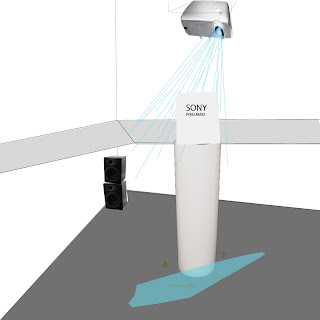Avatar: SONY Pixelmaid
Recreating a metaphysical space, teleporting in any location. A world Surrounded by basic prims, and the ability for objects to move be source code and scripting. Second life is not tangible for everyone, need an account an avatar, it is generally shown to others through the use of machinima. Machinima is a virtual camera in second life to record what’s around you and what you see. My avatar, SONY Pixelmaid, spends most of her time making sculptures on the DMC land.
The entire source would be taken in different clips in SL and brought into after effects, I mainly interested in shooting scenic and my finds upon travel. The .mov file will be hung on top of the ceiling and projected down on the white space, 3d object/ cylinder pedestal. The object itself will be rotating changing to position and direction of the placement of the camera. (The camera is in the similar 3d moving, xyz plane.)
here the is the architectural mock up I did of the sculpture that was presented in class.
A cylinder pedestal constructed from bendable plywood attached to a mechanical rotating device.
Applied on top was a laser cut of to planes leaning agains one another and using the same material my name SONY Pixelmaid was carved out .

Here is the video that was projected on the sculpture as a method of skinning.






































